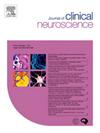Predicting the biomechanical behavior of lumbar intervertebral Discs: A comparative finite element analysis of a novel artificial disc design
IF 1.9
4区 医学
Q3 CLINICAL NEUROLOGY
引用次数: 0
Abstract
Osseointegration along with better mimicry of natural bone behaviour addresses the long-term performance of artificial intervertebral disc prosthesis. Here the effect of a novel artificial intervertebral disc geometry on stress, deformation and strain on lumbar segments to restore movement of the spine was investigated. The process involved, using CT image data, and solid modelling, simulation-driven design and finite element (FE) analysis, hexahedral mesh sensitivity analysis, implant placements. The range of motion (ROM) was calculated using an ANSYS deformation probe. The intact lumbar spine model established was compared with two implants, replacement at segment L4-L5 level, and biomechanical results were compared using axial loads of 500 N, 800 N, 1000 N and 10Nm moment. The two lumbosacral FE models, a novel implant Titanium Conix (TIC) and another FDA approved SB Charite™ (SBC) implant were considered. Novel TIC implant geometry exhibited comparable ROM values in four physiological motions, which were comparable to as required for restoring natural motion. The result shows that the proposed TIC observed the deformation during flexion, extension, bending and twist as 3.43 mm, 3.19 mm, 3.33 mm and 3.48 mm respectively. Similarly strain of 0.01 during flexion, 0.02 during extension, 0.01 during bending and 0.02 during twist. The implants designed in this study demonstrate the suitability of titanium alloy in endplates and annulus. The FE models in the study with their biomechanical parameters can be considered before clinical implementation of any implants, pre-surgery evaluations, implant placement simulations, postsurgical response, follow-up revisions, implant customization and manufacturing.
预测腰椎间盘的生物力学行为:一种新型人工椎间盘设计的比较有限元分析。
骨结合以及更好地模仿天然骨骼的行为可以解决人工椎间盘假体的长期性能问题。本文研究了新型人工椎间盘几何形状对腰椎节段应力、变形和应变的影响,以恢复脊柱的运动。研究过程包括使用 CT 图像数据、实体建模、模拟驱动设计和有限元(FE)分析、六面体网格敏感性分析、植入物放置。使用 ANSYS 变形探针计算运动范围 (ROM)。将所建立的完整腰椎模型与两种植入物进行比较,在 L4-L5 节段进行置换,并使用 500 N、800 N、1000 N 和 10Nm 力矩的轴向载荷对生物力学结果进行比较。两种腰骶部 FE 模型,一种是新型植入物 Titanium Conix(TIC),另一种是经 FDA 批准的 SB Charite™ (SBC)植入物。新型 TIC 植入体的几何形状在四种生理运动中表现出相似的 ROM 值,与恢复自然运动所需的 ROM 值相当。结果显示,拟议的 TIC 在屈曲、伸展、弯曲和扭转时的变形分别为 3.43 毫米、3.19 毫米、3.33 毫米和 3.48 毫米。同样,屈曲时的应变为 0.01,伸展时的应变为 0.02,弯曲时的应变为 0.01,扭转时的应变为 0.02。本研究中设计的植入体证明了钛合金在内板和椎环中的适用性。研究中的有限元模型及其生物力学参数可在临床使用任何种植体、手术前评估、种植体植入模拟、手术后反应、后续修正、种植体定制和制造之前加以考虑。
本文章由计算机程序翻译,如有差异,请以英文原文为准。
求助全文
约1分钟内获得全文
求助全文
来源期刊

Journal of Clinical Neuroscience
医学-临床神经学
CiteScore
4.50
自引率
0.00%
发文量
402
审稿时长
40 days
期刊介绍:
This International journal, Journal of Clinical Neuroscience, publishes articles on clinical neurosurgery and neurology and the related neurosciences such as neuro-pathology, neuro-radiology, neuro-ophthalmology and neuro-physiology.
The journal has a broad International perspective, and emphasises the advances occurring in Asia, the Pacific Rim region, Europe and North America. The Journal acts as a focus for publication of major clinical and laboratory research, as well as publishing solicited manuscripts on specific subjects from experts, case reports and other information of interest to clinicians working in the clinical neurosciences.
 求助内容:
求助内容: 应助结果提醒方式:
应助结果提醒方式:


